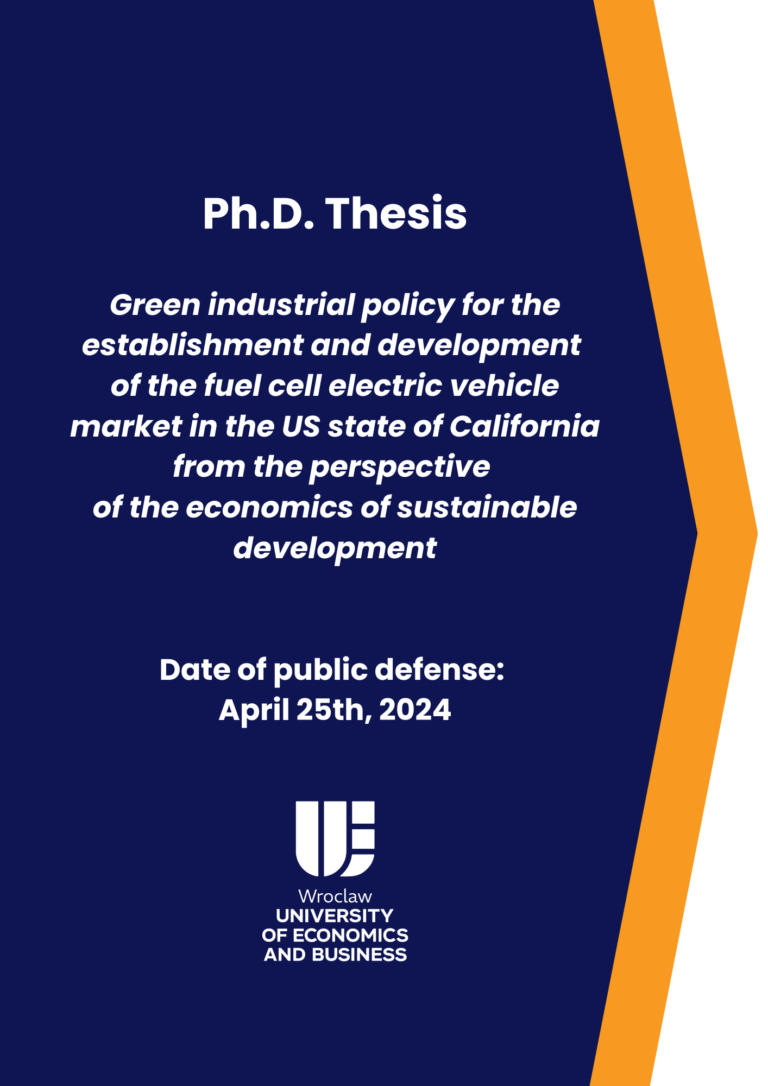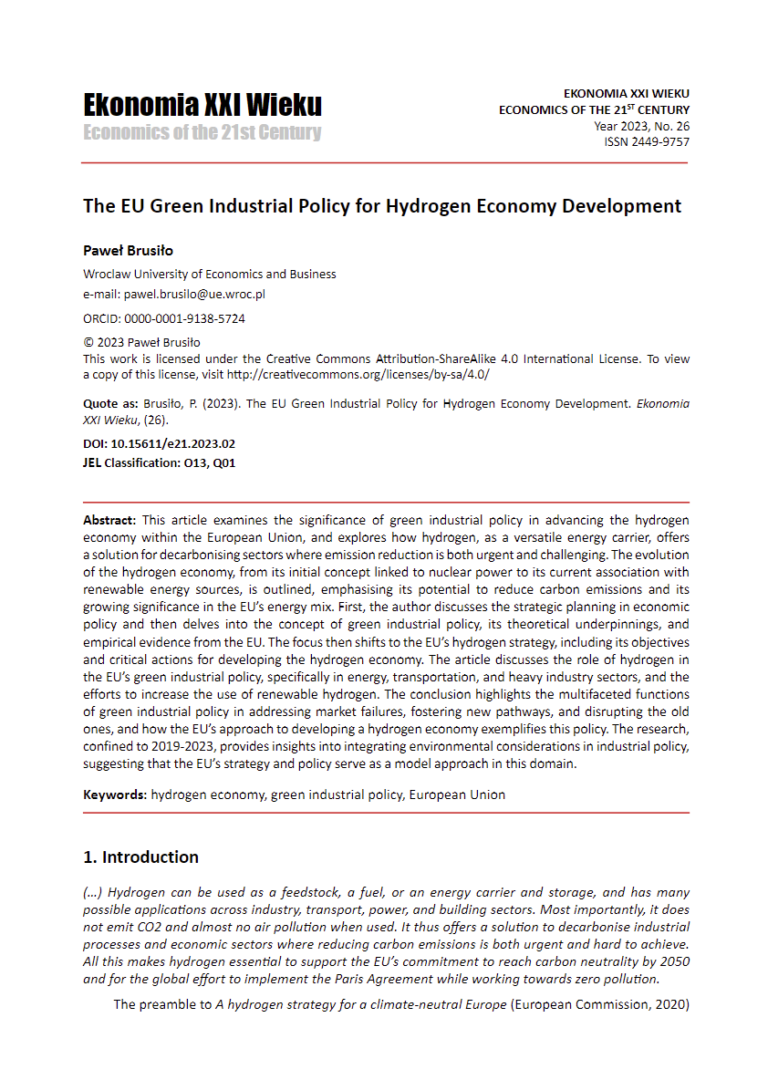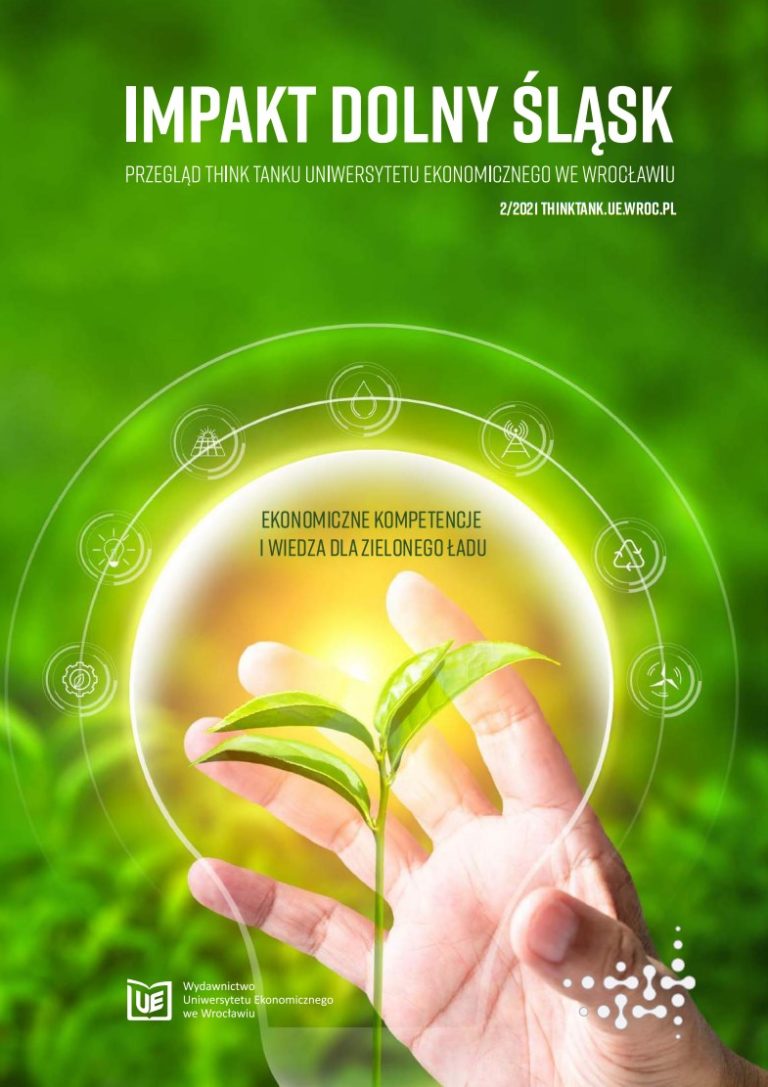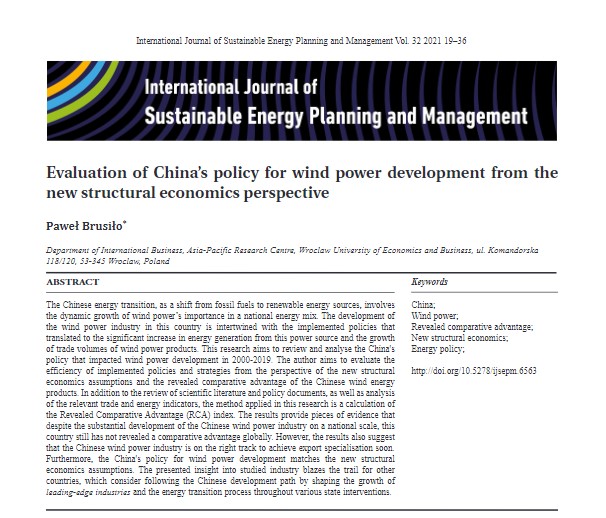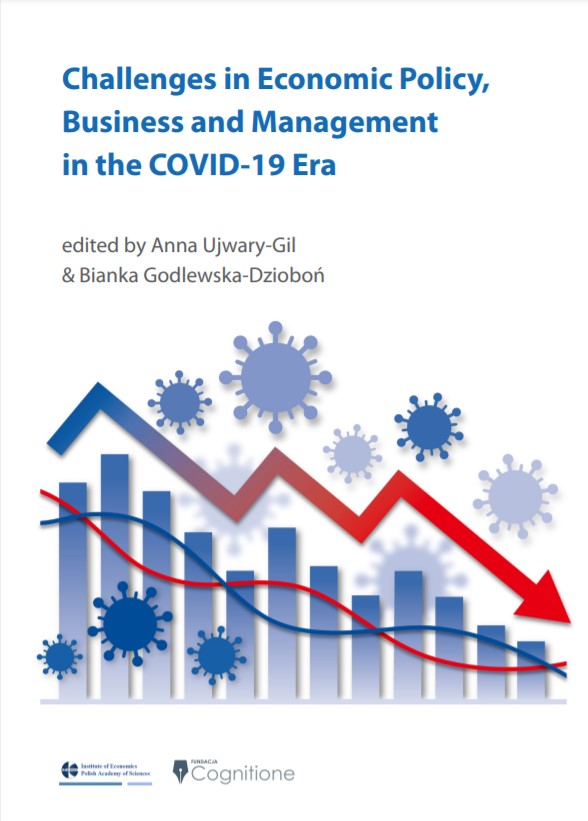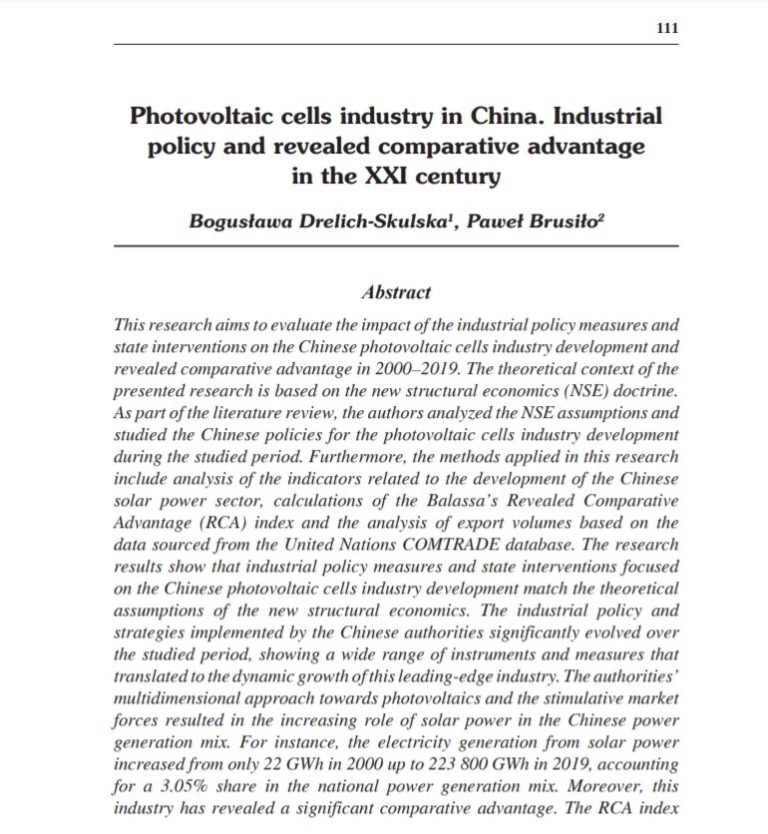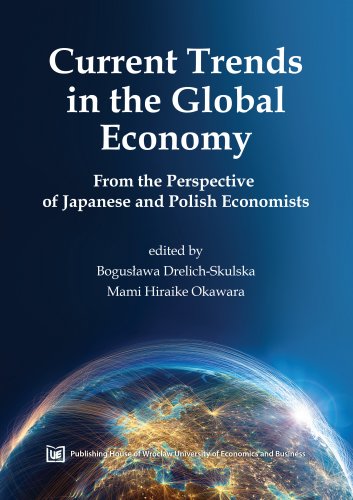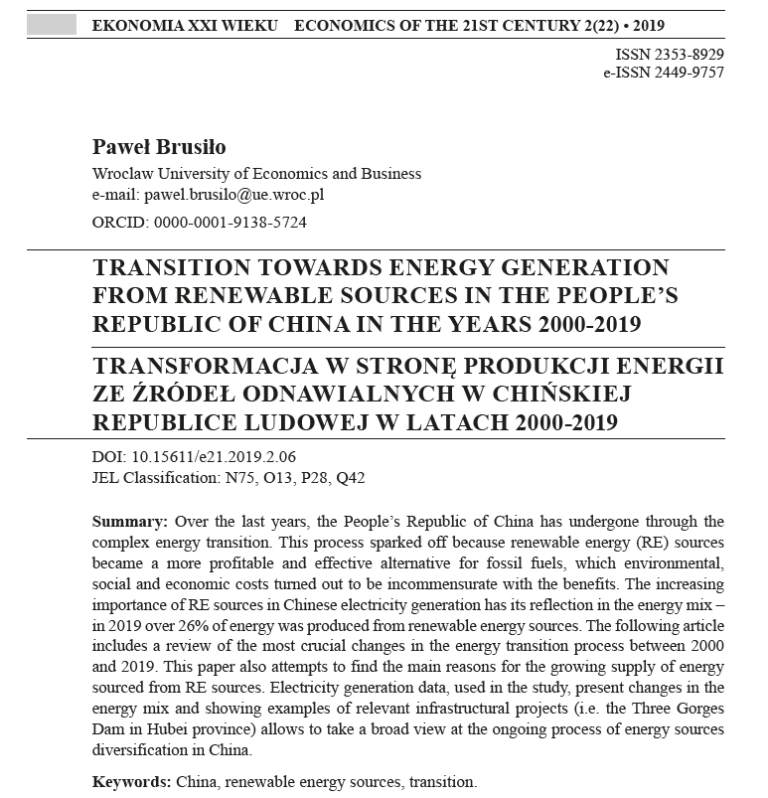Green industrial policy for the establishment and development of the fuel cell electric vehicle market in the US state of California from the perspective of the economics of sustainable development
Brusiło Paweł, 2024, Ph.D. Thesis in Economics and Finance. Date of public defense: April 25th, 2024
The dissertation is devoted to evaluating the impact of green industrial policy on the establishment and development of the hydrogen fuel cell electric vehicle (FCEV) market in California, from the perspective of the economics of sustainable development assumptions. The dissertation synthesizes considerations of the relationship between neoclassical economics, environmental economics, and the economics of sustainable development, emphasizing the importance of aligning green industrial policy with the implementation of its normative postulates. Taking the U.S. state of California as a case study, the author examines how selected green industrial policy instruments influenced the establishment and development of the FCEV market from 1990 to 2022, using quantitative and qualitative research methods, including logical analysis and construction, literature review and individual structured interviews. The dissertation demonstrates that green industrial policy, through its instruments, has had a significant impact on the development of the FCEV market in the state under study, with relevance to both the theoretical assumptions of economics of sustainable development and the practical implications in the area of green industrial policy. The dissertation provides critical insights and suggestions that can serve as a basis for future policy decisions, not only in California, but also in other states and countries pursuing sustainable development in the transportation sector. The dissertation highlights the importance of the hydrogen economy and points to FCEVs as a future direction for transportation development, while offering model assumptions for applying green industrial policy.
The EU green industrial policy for hydrogen economy development
Brusiło Paweł, 2023, article in the Economics of the XXI Century, no. 26, pp. 17-26.
This article examines the significance of green industrial policy in advancing the hydrogen economy within the European Union, and explores how hydrogen, as a versatile energy carrier, offers a solution for decarbonising sectors where emission reduction is both urgent and challenging. The evolution of the hydrogen economy, from its initial concept linked to nuclear power to its current association with renewable energy sources, is outlined, emphasising its potential to reduce carbon emissions and its growing significance in the EU’s energy mix. First, the author discusses the strategic planning in economic policy and then delves into the concept of green industrial policy, its theoretical underpinnings, and empirical evidence from the EU. The focus then shifts to the EU’s hydrogen strategy, including its objectives and critical actions for developing the hydrogen economy. The article discusses the role of hydrogen in the EU’s green industrial policy, specifically in energy, transportation, and heavy industry sectors, and the efforts to increase the use of renewable hydrogen. The conclusion highlights the multifaceted functions of green industrial policy in addressing market failures, fostering new pathways, and disrupting the old ones, and how the EU’s approach to developing a hydrogen economy exemplifies this policy. The research, confined to 2019-2023, provides insights into integrating environmental considerations in industrial policy, suggesting that the EU’s strategy and policy serve as a model approach in this domain.
Hydrogen transition in the European Union and Poland
Drelich-Skulska Bogusława and Brusiło Paweł, 2022, article in the University’s magazine titled: Impakt Dolny Śląsk – the review of the academic think-tank of the Wroclaw University of Economics and Business. Polish version only.
Striving for the development of a low-carbon hydrogen economy is a challenge and an opportunity for many countries to decarbonize energy, transport, and industry in the next decades of the 21st century. Taking such actions is necessary to achieve climate neutrality in Europe and Poland by 2050. Although the hydrogen revolution may seem distant, both individual European Union countries and the EU itself undertake intensive activities aimed at increasing the use of hydrogen in various sectors of the economy. Therefore, it is worth asking the question: what role can hydrogen play in the Polish energy transition in the era of a deepening climate disaster?
Evaluation of China’s policy for wind power development from the new structural economics perspective
Brusiło Paweł, 2021, article in the International Journal of Sustainable Energy Planning and Management, vol. 32, 19-36.
The Chinese energy transition, as a shift from fossil fuels to renewable energy sources, involves the dynamic growth of wind power’s importance in a national energy mix. The development of the wind power industry in this country is intertwined with the implemented policies that translated to the significant increase in energy generation from this power source and the growth of trade volumes of wind power products. This research article reviews and analyzes China’s policy that impacted wind power development in 2000-2019. The author aims to evaluate the efficiency of implemented policies and strategies from the perspective of the new structural economics assumptions and the revealed comparative advantage of the Chinese wind energy products. In addition to the review of scientific literature and policy documents, as well as analysis of the relevant trade and energy indicators, the method applied in this research is a calculation of the Revealed Comparative Advantage (RCA) index. The results provide pieces of evidence that despite the substantial development of the Chinese wind power industry on a national scale, this country still has not revealed a comparative advantage globally. However, the results also suggest that the Chinese wind power industry is on the right track to achieve export specialization soon. Furthermore, China’s policy for wind power development matches the new structural economics assumptions. The presented insight into studied industry blazes the trail for other countries, which consider following the Chinese development path by shaping the growth of leading-edge industries and the energy transition process throughout various state interventions.
The Chinese photovoltaic cells industry and the Belt and Road Initiative: The intra-industry perspective
Brusiło Paweł, 2021, a chapter in the monograph edited by prof. A. Ujwary-Gil and prof. B. Godlewska-Dzioboń titled: Challenges in Economic Policy, Business, and Management in the COVID-19 era. Warsaw: Institute of Economics, Polish Academy of Sciences.
The Belt and Road Initiative (BRI) is one of the most significant infrastructural projects worldwide and a chance for the Chinese photovoltaic cells industry to scale up and expand into new markets. From 2000 to 2019, this industry became a global leader in capacity, export, employment and innovative technology implementation. This study aims to evaluate the Chinese photovoltaic cells industry development in the years 2000–2019 and identify the modern trade patterns and opportunities for this industry alongside the Belt and Road Initiative, especially in the context of intra-industry trade relations. The methods applied in this research include analysing the Grubel-Lloyd trade index and net export volumes, which allowed the author to evaluate and recognise potential trade partners for this technologically advanced industry. The research revealed that the Chinese photovoltaic cells industry underwent substantial changes due to significant state interventionism and implementation of the energy transition policy assumptions. The development of this industry translated to the growth of electricity generation from solar power from less than 1 million MWh in 2000 to over 224 million MWh in 2019. Furthermore, Malaysia, Thailand, and the Republic of Korea accounted for 92.70% of the total imports value of photovoltaic cells in 2019 among the BRI countries. The highest export value of this category of products was associated mainly with the trade relations with the following BRI countries: Republic of Korea, Ukraine, Pakistan, Portugal, Chile and South Africa. Moreover, based on the export data from 2019, the most significant intra-industry trade potential for Chinese photovoltaics was represented by Indonesia, the Philippines, Thailand, the Republic of Korea, Malaysia, Czechia and Singapore. Chinese authorities should accelerate transportation and logistics infrastructure reinforcement (mainly maritime routes through the South China Sea and the Java Sea, and the inland infrastructure). Besides, the Grubel-Lloyd trade index analysis reveals the potential of two-way trade with some EU countries, so the economic and trade cooperation should be tightened and deepened in the export and import of photovoltaic cells between China and the EU. This research article, by the Grubel-Lloyd trade index application, contributes to a better understanding of the potential two-way trade between China and other Belt and Road Initiative countries in the context of the rapidly growing Chinese photovoltaic cells industry.
Photovoltaic cells industry in China. Industrial policy and revealed comparative advantage in the XXI century
Drelich-Skulska Bogusława and Brusiło Paweł, 2021, chapter in the monograph edited by prof. A. Ujwary-Gil and prof. B. Godlewska-Dzioboń, titled: Challenges in Economic Policy, Business, and Management in the COVID-19 era. Warsaw: Institute of Economics, Polish Academy of Sciences.
This research aims to evaluate the impact of the industrial policy measures and state interventions on the Chinese photovoltaic cells industry development and revealed comparative advantage in 2000–2019. The theoretical context of the presented research is based on the new structural economics (NSE) doctrine. As part of the literature review, the authors analyzed the NSE assumptions and studied the Chinese policies for the photovoltaic cells industry development during the studied period. Furthermore, the methods applied in this research include analysis of the indicators related to the development of the Chinese solar power sector, calculations of the Balassa’s Revealed Comparative Advantage (RCA) index and the analysis of export volumes based on the data sourced from the United Nations COMTRADE database. The research results show that industrial policy measures and state interventions focused on the Chinese photovoltaic cells industry development match the theoretical assumptions of the new structural economics. The industrial policy and strategies implemented by the Chinese authorities significantly evolved over the studied period, showing a wide range of instruments and measures that translated to the dynamic growth of this leading-edge industry. The authorities’ multidimensional approach towards photovoltaics and the stimulative market forces resulted in the increasing role of solar power in the Chinese power generation mix. For instance, the electricity generation from solar power increased from only 22 GWh in 2000 up to 223 800 GWh in 2019, accounting for a 3.05% share in the national power generation mix. Moreover, this industry has revealed a significant comparative advantage. The RCA index of the studied industry increased from 0.61977548 up to 3.04388398 in 2000–2019, resulting in a high export specialization in photovoltaic cells on a global scale.
In addition, by 2019, the Chinese photovoltaic cells industry had been an inimitable global leader in terms of capacity, production, export, and innovative technology implementation. By comparing the new structural economics postulates and the Chinese industrial policy towards photovoltaics, the research reveals the substantial role of state interventions in shaping the capital-intensive development of the technologically advanced industries related to renewable energy sources. Research findings provide a starting point for discussion and further research that should consider structural changes within the studied industry and how the Chinese photovoltaic cells industry growth impacted the global value chains and global supply chains. Furthermore, the future study should compare the industrial policy towards analyzed industry in Japan and the other Asia-Pacific countries. To the authors’ best knowledge, the Chinese photovoltaic cells industry has never been studied before in the context of revealed comparative advantage with theoretical background based on the new structural economics. The research results based on the analyzed industry exemplify the trail for the other countries that consider following the Chinese path in shaping the development of their national leading-edge industries related to renewable energy sources, especially solar power.
From Cybersecurity to Economic Security. The EU and Polish Perspective
Drelich-Skulska Bogusława and Brusiło Paweł, 2021, a chapter in the monograph edited by Drelich-Skulska B., Okawara M., titled: Current Trends in the Global Economy. From the Perspective of Japanese and Polish Economists. Wrocław: Publishing House of the Wroclaw University of Economics and Business.
The third chapter of our Polish-Japanese monograph presents an overview of the crucial global trend
that involves the changes and challenges in the area of cybersecurity. Firstly, the authors described the evolution of the cybersecurity concept in the context of economic security. The conducted analysis reveals that cyberspace security has already become a substantial determinant of economic security, since the information and communication technologies irreversibly change fundamental areas of human, entrepreneurial and institutional activities. Furthermore, the role of cybersecurity that constitutes economic security nowadays was investigated both on international and national levels. The authors conducted two case studies of the EU and Polish cybersecurity systems and strategic approaches, which then allowed to offer their insights towards the diverse cybersecurity issues, and provide recommendations in the field of cooperation between various stakeholders.
Transition towards energy generation from renewable sources in the People’s Republic of China
Brusiło Paweł, 2019, article in the Economics of the XXI Century, vol. 2 no 22, pp. 85-97.
My first research article presents an overivew of the complex energy transition that the People’s Republic of China has undergone over the last two decades. This process sparked off because renewable energy (RE) sources became a more profitable and effective alternative for fossil fuels, which environmental, social and economic costs turned out to be incommensurate with the benefits. The increasing importance of RE sources in Chinese electricity generation has its reflection in the energy mix – in 2019 over 26% of energy was produced from renewable energy sources. This article includes a review of the most crucial changes in the energy transition process between 2000 and 2019. Furthermore, this paper also attempts to find the main reasons for the growing supply of energy sourced from RE sources. Electricity generation data, used in the study, present changes in the energy mix and by showing examples of relevant infrastructural projects (i.e. the Three Gorges Dam in Hubei province) allows to take a broad view at the ongoing process of energy sources diversification in China.
